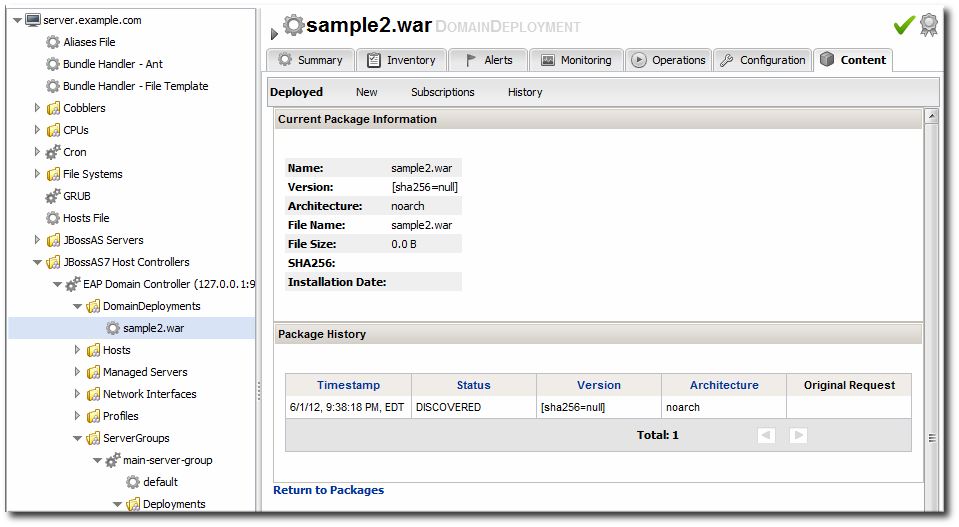-
Language:
English
-
Language:
English
Red Hat Training
A Red Hat training course is available for Red Hat JBoss Operations Network
Chapter 8. Deploying Web Applications
Web applications are a unique type of resource. They are added as child resources of servers, so they have a place within the inventory with their own entries, possibly even their own child resources, and independent configuration for monitoring, alerting, and operations. However, web applications are content-backed resources. Ultimately, they are software packages, not true servers or services.
Managing a content-backed resource requires a path to make the initial deployment (creating the deployment as a child resource) and also a path for patches and updates (content updates).
8.1. Runtime Information and Deployment Resources
8.1.1. Views of Deployments
Both EAP 6 and JBoss ON offer clear workflows for adding web applications to a central content repository and then associating that content with a server group. But the perspectives they offer are very different, so deciding which console to use depends on what needs to be accomplished at that particular moment.
The EAP 6 console is focused on immediately associating content with a server group. In the EAP 6 console, deployments are treated similarly to shared configuration, like a JVM definition. A content package is deployed to a domain controller or a server group and is then associated with a managed server.

Figure 8.1. Deployments in the Runtime Page
JBoss ON is focused on lifecycle management for web application, an historical and changing perspective. There are a few fundamental differences in how JBoss ON defines web applications:
- A web application is treated as a separate entity, in and of itself. It has its own place in the inventory; its association with domains and server groups is reflected as it is a child of those resources.JBoss ON also records package details, like its file size and an identifying SHA256 hash.
- A web application has a history. Updates to packages are recorded in a changelog which makes it possible to track how the application has been maintained.
- Web applications can be monitored. Response time metrics specifically track the performance of web applications, apart from the performance or monitoring of the underlying server.

Figure 8.2. Deployment Resource Details in JBoss ON
The reason for this emphasis on web applications as a resource is that the core purpose is not the simple task of deploying content to a server. The EAP 6 console does that very simply and cleanly. The purpose of JBoss ON management is administration of that content of a web application:
- Creating content repositories to store patches and updates
- Tracking multiple versions of content
- Reverting software packages to a previous version (particularly for standalone servers)
- Using the same content repository for multiple EAP instances, including multiple domains and standalone server
- Tracking (and auditing) changes to content
8.1.2. Deployment Paths for Standalone Servers and Domains
There is a radically different structure between standalone servers and domains, and that impacts the content flow for deploying web applications.
Web application deployments in standalone servers are similar to EAP 5, in that there is a local filesystem directory which is used for deployments. Locally, applications can be added to that deployment directory and hot-deployed. Using JBoss ON, there are two paths for deploying web applications:
- Create a deployment as a child resource
- Use a bundle to provision the application in the deployment directory
Using bundles is a versatile and practical management method, because the bundle system has capabilities to store multiple versions, rollback updates, skip versions for updates, or purge deployments, all with a single button.
Unfortunately, the bundles system only works with real filesystem locations. The distributed and modular structure for JBoss EAP 6 domains means that bundles are not an option.
For EAP 6 domains, the content is deployed as a child resource to the domain and then is propagated to server groups by administrators.
It lacks the flexibility and finesse of the bundles system, but using the ordinary content system still offers ways to control content versions and updates. Content-backed resources can be associated with content repositories in JBoss ON. These repositories can store all sorts of software packages, from different content sources. Packages from the repo can be installed on the resource selectively. Additionally, a resource can be associated with multiple repos. While not as fluid as updating or reverting changes with bundles, the content repositories in JBoss ON provide a pathway to apply individual patch files to a web application or to roll out full updates.
Content management in general is described in "Deploying Applications and Content". This covers setting up content repositories, subscribing resources, and pushing updates.

